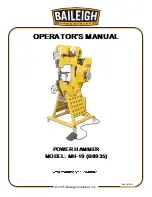
3
PLACING TOOL IN SERVICE
TORQUE CONTROL INFORMATION
These tools are furnished with two types of Torsion Bars.
Models 5020TDQ and 5040TDQ have a non–adjustable
Torsion Bar and a Quick Change Anvil Assembly which
permits rapid interchangeability of Bars to achieve the desired
torque setting. (Refer to the table in Form P7069.) Models
5020T and 5040T have an integral adjustable Torsion Bar
which enables one Bar to be used through a range of torque
output. (Refer to the table in Form P7069.) A Torque Setting
Jig is required to set the torque on models having an
adjustable Torsion Bars.
Non–adjustable Torsion Bars
There are two indicators which reveal the torque capability of
non–adjustable torsion bars. Each bar is color coded with one
of six colors. Because these colors are used on more than one
bar, each bar is additionally coded with a stamped number
from one to twelve that is unique to that particular bar. The
number can be found stamped on the large hub near the Quick
Change Anvil Assembly. (Refer to Drawing TPC588 and table
in Form P7069.)
Adjustable Torsion Bars
Check the stamping on the end face of the square driver to
determine what torque range the torsion bar is capable of
handling. The letter “H” designates a Heavy Torsion Bar, the
letter “M” designates a Medium Torsion Bar and the letter “L”
designates a Light Torsion Bar. (Refer to the Adjustable
Torsion Bar Table in Form P7069 to determine the precise
range of Heavy, Medium or Light Bars with different size
Impactools.) All Torsion Bars are adjusted at the factory for
controlling the torque when installing fasteners having
right–hand threads.
Torque Setting Jigs
There are two types of Torque Setting Jigs available from
Ingersoll–Rand.
A Vise Type Torque Setting Jig consisting of two jaws used in
a bench vise is available for Model 5020T and Model 5040T
and is capable of setting torque for right–hand and left–hand
fasteners.
The Screw Type Torque Setting Jig is a self–contained,
base–mounted unit using a screw–actuated Torque Jig Arm to
make the adjustment. The Screw Type Jig for model 5040T
will adjust torque for right–hand fasteners and left–hand
fastening torque can be done by removing the Torque Jig
Clamps from the Screw Type Jig and using them in vise jaws.
Changing the Permanent Set From Right–Hand
to Left–Hand
The Screw Type Torque Setting Jig cannot be used to remove
the permanent set placed on the Torsion Bar at the factory.
However, by removing the Torque Jig Clamp from the Jig and
using the clamp jaws with a bench vise, the permanent set can
be changed as follows:
1.
Remove the Torque Locking Sleeve Retainer from the
Adjustable Torsion Bar.
2.
Clamp the Torque Jig Clamp around the Anvil
and grip the jaws tightly in a vise.
3.
Place a square socket over the end of the Torsion Bar
until it just touches the Socket Retaining Plunger. Use a
long socket handle to obtain sufficient leverage.
4.
While pulling the socket handle clockwise when facing
the square driver, disengage the Torque Locking Sleeve
from the Torsion Bar by lifting it out of spline
engagement with your free hand. Gradually relax the pull
on the socket handle, allowing the Torsion Bar to assume
an unstressed position. Remove the socket handle and the
Torque Locking Sleeve.
5.
Apply a torque wrench to the square driver of the
Torsion Bar and pull the wrench counterclockwise
when facing the square driver until the following
torque values are reached.
For 5020T models, 25 ft–lb (34 Nm) for Light Bars; 35
ft–lb (48 Nm) for Heavy Bars.
For 5040T models, 50 ft–lb (68 Nm) for Light Bars; 70
ft–lb (95 Nm) for Medium Bars; 160 ft–lb
(217 Nm) for Heavy Bars.
6.
Relax the pull on the torque wrench and allow the Bar to
assume its natural position. Note that it has taken a
slight permanent set. Make adjustments for left–hand
operation as described in the following instructions.
Adjusting an Operational Torsion Bar Using a Vise
Type Jig
1.
Remove the Torque Locking Sleeve Retainer from the
Adjustable Torsion Bar.
2.
Clamp the Torque Jig Clamp around the Anvil
and grip the jaws tightly in a vise with the square driver
upward.
3.
Note the position of the Torque Locking Sleeve
and make a pencil mark on the face of the Jig directly in
line with one of the numbers.
4.
Place a wrench or square socket over the end of the
Torsion Bar until it just touches the Socket Retaining
Plunge . Use a long handle tool to obtain sufficient
leverage.




































